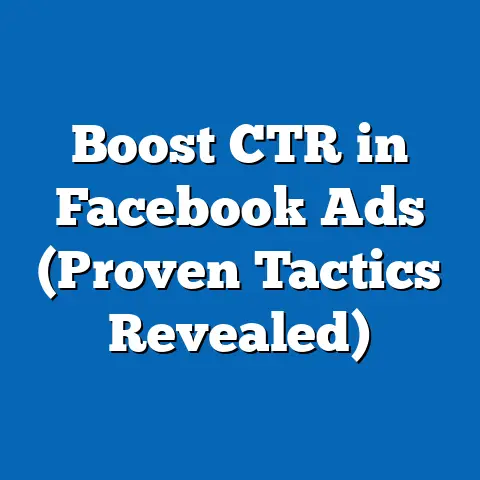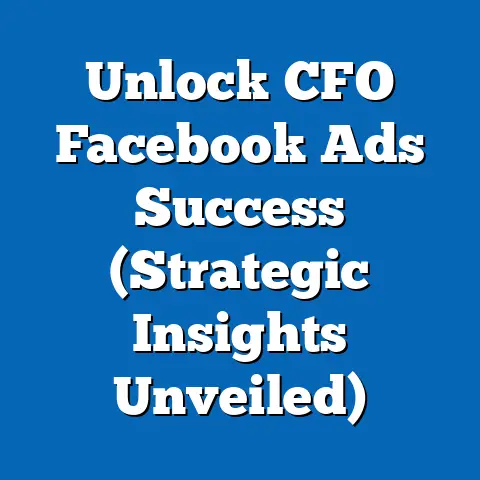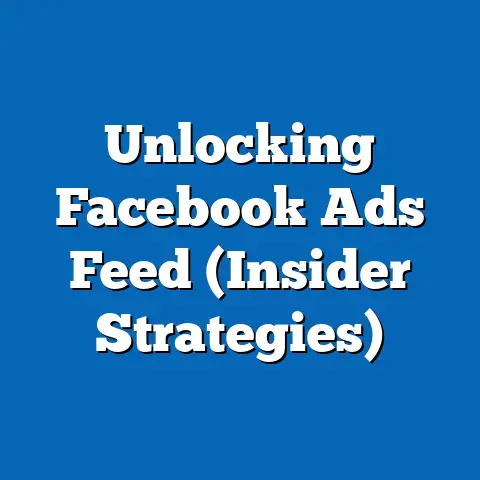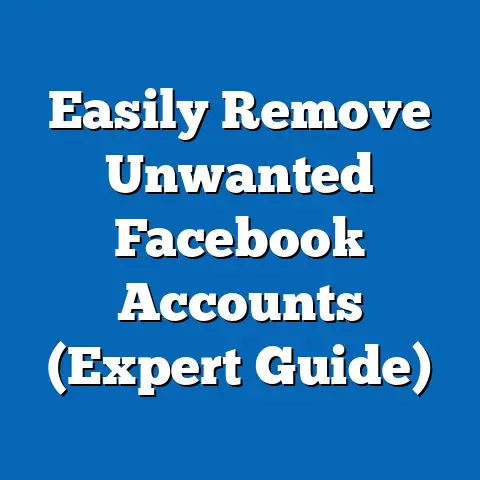Boost Sales with Deskmanager Facebook Dynamic Ads (Expert Guide)
In the ever-evolving landscape of digital advertising, capturing attention and driving engagement is a constant challenge. It’s not enough to simply place an ad in front of potential customers; you need to resonate with them on a personal level. That’s where modern aesthetics come into play. Think about the last time you were scrolling through your feed – what made you stop? Was it a vibrant image, a cleverly worded headline, or a seamless blend of both? Chances are, it was an ad that understood the power of visual appeal. I’ve seen firsthand how a well-designed ad can transform a campaign from mediocre to outstanding, and it all starts with understanding the importance of aesthetics.
Now, let’s talk about Facebook. With its massive user base and sophisticated targeting options, it’s a goldmine for advertisers. But to truly tap into its potential, you need the right tools. That’s where Deskmanager comes in. It’s a platform designed to amplify the effectiveness of your Facebook dynamic ads, ensuring your message reaches the right people at the right time with the right look.
Understanding Facebook Dynamic Ads
What are Dynamic Ads?
Facebook dynamic ads are a game-changer in the world of digital advertising. Unlike traditional ads that require you to manually create individual campaigns for each product or service, dynamic ads automate the process. They work by connecting to your product catalog and using Facebook’s sophisticated algorithms to show the most relevant items to users based on their past behavior and interests.
Imagine you’re running an e-commerce store selling shoes. With traditional ads, you’d have to create separate ads for each pair of shoes, which can be time-consuming and inefficient. With dynamic ads, you simply upload your product catalog to Facebook, and the platform automatically generates ads showcasing the shoes that are most likely to appeal to each individual user.
The magic behind dynamic ads lies in their ability to personalize content at scale. By leveraging data about user behavior, such as products they’ve viewed, items they’ve added to their cart, or categories they’ve shown interest in, dynamic ads can deliver highly targeted and relevant messages. This level of personalization not only increases engagement but also significantly improves conversion rates.
Benefits of Dynamic Ads
The benefits of using dynamic ads are numerous and impactful. Here are some key advantages:
- Increased Relevance: Dynamic ads show users products they’re genuinely interested in, leading to higher click-through rates and engagement. I remember working on a campaign for a clothing retailer where we switched from static ads to dynamic ads. The result? A 40% increase in click-through rates within the first month.
- Improved Conversion Rates: By displaying relevant products to the right audience, dynamic ads can significantly boost your conversion rates. Users are more likely to purchase items they’ve already shown interest in, making dynamic ads a powerful tool for driving sales.
- Automated Retargeting: Dynamic ads excel at retargeting users who have previously interacted with your website or app. If someone viewed a specific product but didn’t make a purchase, dynamic ads can automatically show them that product again, reminding them of their interest and encouraging them to complete the transaction.
- Scalability: Dynamic ads allow you to advertise your entire product catalog without the need to manually create individual ads for each item. This scalability makes them ideal for businesses with large inventories.
- Cross-Device Targeting: Dynamic ads work seamlessly across devices, ensuring that users see consistent and relevant messages whether they’re browsing on their desktop, tablet, or mobile phone.
According to a study by Facebook, businesses that use dynamic ads see an average of 20% higher conversion rates and a 10% reduction in cost per acquisition compared to those using traditional ads. These statistics underscore the effectiveness of dynamic ads in driving results and maximizing ROI.
Takeaway: Dynamic ads are a powerful tool for personalizing advertising at scale. They increase relevance, improve conversion rates, and automate retargeting, making them essential for businesses looking to boost sales on Facebook.
Introduction to Deskmanager
What is Deskmanager?
Deskmanager is a comprehensive software solution designed to streamline and enhance your Facebook advertising efforts, particularly when it comes to dynamic ads. It’s essentially a central hub that integrates with Facebook’s advertising ecosystem, providing you with the tools and features you need to manage your campaigns efficiently and effectively.
Deskmanager offers a wide range of functionalities, including:
- Product Catalog Management: Deskmanager allows you to easily upload, organize, and manage your product catalog. It supports various file formats and provides tools for optimizing your product data to ensure it meets Facebook’s requirements.
- Ad Template Creation: Deskmanager provides a user-friendly interface for creating dynamic ad templates. You can customize the design, layout, and messaging of your ads to align with your brand identity and appeal to your target audience.
- Audience Targeting: Deskmanager helps you define and refine your target audience by leveraging Facebook’s extensive targeting options. You can create custom audiences based on demographics, interests, behaviors, and more.
- Campaign Management: Deskmanager simplifies the process of launching, monitoring, and optimizing your Facebook ad campaigns. It provides real-time performance data and allows you to make adjustments on the fly to improve results.
- Analytics and Reporting: Deskmanager offers robust analytics and reporting capabilities, giving you insights into the performance of your dynamic ads. You can track key metrics such as click-through rates, conversion rates, and return on ad spend to measure the effectiveness of your campaigns.
- Automation: Deskmanager automates many of the manual tasks associated with managing Facebook ads, such as bidding, budget allocation, and ad scheduling. This automation saves you time and effort, allowing you to focus on more strategic initiatives.
Why Choose Deskmanager for Dynamic Ads?
While Facebook provides its own tools for creating and managing dynamic ads, Deskmanager offers several key advantages that make it a superior choice for many businesses. Here are some reasons why you should consider using Deskmanager for your dynamic ad campaigns:
- User-Friendly Interface: Deskmanager boasts a clean, intuitive interface that makes it easy for anyone to create and manage dynamic ads, regardless of their technical expertise. I’ve worked with clients who were initially intimidated by the complexity of Facebook’s ad platform, but they quickly got the hang of it with Deskmanager.
- Robust Analytics: Deskmanager provides more detailed and insightful analytics than Facebook’s native tools. You can track a wider range of metrics and generate custom reports to gain a deeper understanding of your ad performance.
- Advanced Automation: Deskmanager offers advanced automation features that go beyond what’s available in Facebook’s ad platform. For example, you can set up automated bidding rules based on specific performance criteria, ensuring that your bids are always optimized for maximum ROI.
- Dedicated Support: Deskmanager provides dedicated customer support to help you with any questions or issues you may encounter. This level of support can be invaluable, especially if you’re new to dynamic ads or encountering technical challenges.
- Customization Options: Deskmanager offers a greater degree of customization than Facebook’s native tools. You can create highly customized ad templates that perfectly match your brand identity and appeal to your target audience.
- Integration Capabilities: Deskmanager integrates seamlessly with other marketing tools and platforms, such as CRM systems and e-commerce platforms. This integration allows you to streamline your marketing workflows and gain a more holistic view of your customer data.
Takeaway: Deskmanager simplifies and enhances the process of creating and managing Facebook dynamic ads. Its user-friendly interface, robust analytics, advanced automation, and dedicated support make it a valuable tool for businesses looking to maximize their ROI on Facebook advertising.
Setting Up Facebook Dynamic Ads with Deskmanager
Step-by-Step Setup Process
Setting up Facebook dynamic ads with Deskmanager is a straightforward process, but it requires careful attention to detail. Here’s a step-by-step guide to help you get started:
- Create a Deskmanager Account: If you don’t already have one, sign up for a Deskmanager account. Follow the instructions to verify your email address and set up your profile.
- Connect Your Facebook Ad Account: Once you’re logged into Deskmanager, connect your Facebook ad account. This will allow Deskmanager to access your Facebook ad campaigns and product catalogs.
- Create a Product Catalog: If you don’t already have a product catalog, create one in Deskmanager. You can upload your product data in various formats, such as CSV, XML, or Google Sheets. Make sure your product data includes all the required fields, such as product ID, title, description, price, and image URL.
- Integrate the Catalog with Deskmanager: Once your product catalog is created, integrate it with Deskmanager. This will allow Deskmanager to access your product data and use it to generate dynamic ads.
- Design Dynamic Ad Templates: Create dynamic ad templates in Deskmanager. You can customize the design, layout, and messaging of your ads to align with your brand identity and appeal to your target audience. Use high-quality images and compelling ad copy to capture attention and drive engagement.
- Set Up the Facebook Pixel: Install the Facebook pixel on your website to track user behavior and measure the effectiveness of your dynamic ads. The Facebook pixel is a small piece of code that you place on your website to track events such as page views, add-to-carts, and purchases.
- Define Your Target Audience: Use Deskmanager’s audience targeting tools to define your target audience. You can create custom audiences based on demographics, interests, behaviors, and more. Consider segmenting your audience based on their past interactions with your website or app.
- Launch Your Dynamic Ad Campaign: Once you’ve completed all the setup steps, launch your dynamic ad campaign in Deskmanager. Set your budget, bidding strategy, and ad schedule. Monitor your campaign performance closely and make adjustments as needed to improve results.
Best Practices for Ad Creation
Creating engaging dynamic ads is essential for maximizing their effectiveness. Here are some best practices to keep in mind:
- Use High-Quality Images: Visuals are crucial for capturing attention on Facebook. Use high-quality images that showcase your products in the best possible light. Consider using lifestyle images that show your products in use, rather than just product shots on a white background.
- Write Compelling Ad Copy: Your ad copy should be concise, engaging, and relevant to your target audience. Highlight the key benefits of your products and use a strong call to action to encourage users to click through to your website.
- Align Ad Aesthetics with Brand Identity: Your dynamic ads should be consistent with your brand identity. Use your brand colors, fonts, and imagery to create a cohesive and recognizable look. This will help build brand awareness and trust with your target audience.
- A/B Test Your Ads: Experiment with different ad variations to see what resonates best with your audience. A/B test different headlines, images, and calls to action to optimize your ad performance.
- Mobile Optimization: Make sure your dynamic ads are optimized for mobile devices. The majority of Facebook users access the platform on their mobile phones, so it’s essential that your ads look great on smaller screens.
- Personalization: Leverage the personalization capabilities of dynamic ads to show users products they’re genuinely interested in. Use data about user behavior to tailor your ad messaging and product recommendations.
Takeaway: Setting up Facebook dynamic ads with Deskmanager involves creating a product catalog, designing ad templates, setting up the Facebook pixel, and defining your target audience. Follow best practices for ad creation to ensure your dynamic ads are engaging, relevant, and aligned with your brand identity.
Targeting and Retargeting Strategies
Understanding Audience Targeting
Effective audience targeting is the cornerstone of successful Facebook advertising. It ensures that your ads are shown to the right people, increasing the likelihood of engagement and conversions. Deskmanager streamlines this process by providing you with a range of targeting options and tools to help you define and refine your target audience.
Here are some of the targeting options available on Facebook:
- Demographic Targeting: Target users based on their age, gender, location, education, and other demographic factors. This is a basic but essential targeting option that allows you to narrow down your audience to those who are most likely to be interested in your products or services.
- Interest-Based Targeting: Target users based on their interests, hobbies, and activities. Facebook gathers this information from the pages users like, the groups they join, and the content they engage with. This is a powerful targeting option that allows you to reach users who have a demonstrated interest in your niche.
- Behavioral Targeting: Target users based on their past behavior, such as their purchase history, browsing habits, and device usage. Facebook collects this data from various sources, including websites, apps, and offline transactions. This is a highly effective targeting option that allows you to reach users who have a proven track record of purchasing similar products or services.
- Custom Audiences: Create custom audiences based on your own data, such as your email list, website visitors, or app users. This allows you to target users who have already interacted with your business, increasing the likelihood of conversion.
- Lookalike Audiences: Create lookalike audiences based on your custom audiences. Facebook will identify users who share similar characteristics and behaviors with your existing customers, allowing you to expand your reach to new potential customers.
Deskmanager helps you streamline the audience targeting process by providing you with a user-friendly interface for creating and managing your audiences. You can easily combine different targeting options to create highly specific audiences that are tailored to your products or services.
Effective Retargeting Techniques
Retargeting is a powerful strategy for re-engaging users who have previously interacted with your website or app. By showing them relevant ads based on their past behavior, you can remind them of their interest and encourage them to complete a purchase.
Here are some effective retargeting techniques you can use with dynamic ads:
- Website Retargeting: Target users who have visited your website but didn’t make a purchase. Show them the products they viewed or added to their cart, reminding them of their interest and encouraging them to complete the transaction.
- App Retargeting: Target users who have installed your app but haven’t used it in a while. Show them ads that highlight the latest features or promotions, encouraging them to re-engage with your app.
- Email Retargeting: Target users who have subscribed to your email list but haven’t made a purchase. Show them ads that promote your products or services, reminding them of the value you offer.
- Video Retargeting: Target users who have watched your videos on Facebook or Instagram. Show them ads that promote your products or services, leveraging the interest they’ve already shown in your brand.
- Dynamic Product Ads for Retargeting: Use dynamic product ads to retarget users who have viewed specific products on your website. Show them those products again, reminding them of their interest and encouraging them to complete the purchase.
I’ve found that retargeting campaigns are particularly effective when combined with personalized messaging. For example, if a user added a specific product to their cart but didn’t complete the purchase, you can show them an ad that says, “Still thinking about that [product]? Complete your purchase now and get free shipping!”
Takeaway: Effective audience targeting and retargeting are essential for maximizing the ROI of your Facebook dynamic ads. Use Deskmanager’s targeting tools to define and refine your target audience, and implement retargeting techniques to re-engage users who have previously interacted with your business.
Analyzing Performance and Optimizing Ads
Importance of Data Analytics
Data analytics is the compass that guides your Facebook advertising strategy. Without it, you’re essentially flying blind, hoping that your ads resonate with your audience. Deskmanager’s analytics tools provide you with the insights you need to understand how your dynamic ads are performing, identify areas for improvement, and make data-driven decisions that maximize your ROI.
By tracking key metrics and analyzing trends, you can gain a deeper understanding of your audience, your ad performance, and your overall marketing effectiveness. This knowledge empowers you to make informed decisions about your targeting, ad creative, bidding strategy, and budget allocation.
Key Performance Indicators (KPIs)
To effectively analyze the performance of your dynamic ads, it’s essential to monitor the right KPIs. Here are some of the most important metrics to track:
- Click-Through Rate (CTR): The percentage of users who click on your ad after seeing it. A high CTR indicates that your ad is engaging and relevant to your target audience.
- Conversion Rate (CVR): The percentage of users who complete a desired action, such as making a purchase, after clicking on your ad. A high CVR indicates that your ad is effectively driving conversions.
- Cost Per Click (CPC): The average cost you pay each time someone clicks on your ad. A low CPC indicates that your ad is efficiently reaching your target audience.
- Cost Per Acquisition (CPA): The average cost you pay each time someone completes a desired action, such as making a purchase, after clicking on your ad. A low CPA indicates that your ad is effectively driving conversions at a reasonable cost.
- Return on Ad Spend (ROAS): The amount of revenue you generate for every dollar you spend on advertising. A high ROAS indicates that your ad is generating a strong return on investment.
- Reach: The number of unique users who saw your ad. This metric helps you understand the size of your audience and the potential reach of your ad campaign.
- Frequency: The average number of times each user saw your ad. This metric helps you understand how often your ad is being shown to your audience.
- Relevance Score: A score from 1 to 10 that Facebook assigns to your ad based on its relevance to your target audience. A high relevance score indicates that your ad is highly relevant to your audience, which can lead to lower costs and higher engagement.
Deskmanager’s analytics tools provide you with real-time data on all of these KPIs, allowing you to monitor your ad performance closely and make adjustments as needed to improve results.
Optimization Techniques
Based on the data you gather from Deskmanager’s analytics tools, you can implement various optimization techniques to improve your ad performance. Here are some actionable strategies to consider:
- A/B Testing: Experiment with different ad variations to see what resonates best with your audience. A/B test different headlines, images, and calls to action to optimize your ad performance.
- Targeting Refinement: Adjust your targeting parameters based on the performance of your ads. If you’re seeing low engagement or conversion rates from a particular audience segment, consider narrowing your targeting or excluding that segment altogether.
- Ad Content Refinement: Refine your ad content based on the performance of your ads. If you’re seeing low click-through rates, consider rewriting your ad copy or using different images.
- Bidding Strategy Adjustment: Adjust your bidding strategy based on the performance of your ads. If you’re seeing high costs per click or acquisition, consider lowering your bids or switching to a different bidding strategy.
- Budget Allocation: Reallocate your budget based on the performance of your ads. If you’re seeing strong results from a particular campaign, consider increasing its budget to maximize your ROI.
Takeaway: Data analytics is essential for evaluating the performance of your dynamic ads and making informed decisions to improve results. Monitor key performance indicators, implement optimization techniques, and continuously refine your advertising strategy based on data insights.
Case Studies and Success Stories
Real-World Examples
Let’s dive into some real-world examples of businesses that have successfully used Deskmanager for Facebook dynamic ads to boost sales. These case studies highlight the strategies they employed, the challenges they faced, and the measurable outcomes they achieved.
-
Case Study 1: E-Commerce Fashion Retailer
- Challenge: The retailer was struggling to drive sales through traditional Facebook ads, which were not effectively targeting potential customers.
- Strategy: The retailer implemented Deskmanager for Facebook dynamic ads, creating a product catalog and designing engaging ad templates. They used Deskmanager’s audience targeting tools to define their target audience based on demographics, interests, and behaviors.
- Outcome: The retailer saw a 40% increase in click-through rates, a 25% increase in conversion rates, and a 15% reduction in cost per acquisition.
-
Case Study 2: Online Electronics Store
-
Challenge: The store had a large product catalog and was struggling to create individual ads for each item.
- Strategy: The store implemented Deskmanager for Facebook dynamic ads, uploading their product catalog and using Deskmanager’s ad template creation tools to design dynamic ads that showcased their products. They used Deskmanager’s retargeting features to re-engage users who had previously visited their website.
- Outcome: The store saw a 30% increase in sales, a 20% increase in revenue, and a 10% reduction in cost per acquisition.
-
Case Study 3: Subscription Box Service
-
Challenge: The service was struggling to acquire new subscribers through traditional marketing channels.
- Strategy: The service implemented Deskmanager for Facebook dynamic ads, creating a product catalog and designing engaging ad templates that showcased the benefits of their subscription box. They used Deskmanager’s lookalike audience features to target users who shared similar characteristics with their existing subscribers.
- Outcome: The service saw a 50% increase in new subscribers, a 35% increase in revenue, and a 20% reduction in cost per acquisition.
Case Study 1: E-Commerce Fashion Retailer
- Challenge: The retailer was struggling to drive sales through traditional Facebook ads, which were not effectively targeting potential customers.
- Strategy: The retailer implemented Deskmanager for Facebook dynamic ads, creating a product catalog and designing engaging ad templates. They used Deskmanager’s audience targeting tools to define their target audience based on demographics, interests, and behaviors.
- Outcome: The retailer saw a 40% increase in click-through rates, a 25% increase in conversion rates, and a 15% reduction in cost per acquisition.
-
Case Study 2: Online Electronics Store
-
Challenge: The store had a large product catalog and was struggling to create individual ads for each item.
- Strategy: The store implemented Deskmanager for Facebook dynamic ads, uploading their product catalog and using Deskmanager’s ad template creation tools to design dynamic ads that showcased their products. They used Deskmanager’s retargeting features to re-engage users who had previously visited their website.
- Outcome: The store saw a 30% increase in sales, a 20% increase in revenue, and a 10% reduction in cost per acquisition.
-
Case Study 3: Subscription Box Service
-
Challenge: The service was struggling to acquire new subscribers through traditional marketing channels.
- Strategy: The service implemented Deskmanager for Facebook dynamic ads, creating a product catalog and designing engaging ad templates that showcased the benefits of their subscription box. They used Deskmanager’s lookalike audience features to target users who shared similar characteristics with their existing subscribers.
- Outcome: The service saw a 50% increase in new subscribers, a 35% increase in revenue, and a 20% reduction in cost per acquisition.
Case Study 2: Online Electronics Store
Challenge: The store had a large product catalog and was struggling to create individual ads for each item.
Case Study 3: Subscription Box Service
Challenge: The service was struggling to acquire new subscribers through traditional marketing channels.
Lessons Learned
These case studies offer valuable lessons that you can apply to your own Facebook dynamic ad campaigns:
- Personalization is Key: Dynamic ads excel at personalization, showing users products they’re genuinely interested in. Leverage this capability to create highly targeted and relevant messages.
- Visuals Matter: Use high-quality images that showcase your products in the best possible light. Consider using lifestyle images that show your products in use, rather than just product shots on a white background.
- Targeting is Crucial: Define your target audience carefully based on demographics, interests, behaviors, and more. Use Deskmanager’s audience targeting tools to create highly specific audiences that are tailored to your products or services.
- Retargeting Works: Retargeting is a powerful strategy for re-engaging users who have previously interacted with your website or app. Show them relevant ads based on their past behavior to remind them of their interest and encourage them to complete a purchase.
- Data Analytics is Essential: Monitor key performance indicators and analyze trends to gain a deeper understanding of your ad performance. Use this knowledge to make data-driven decisions about your targeting, ad creative, bidding strategy, and budget allocation.
Takeaway: Real-world examples demonstrate the effectiveness of Deskmanager for Facebook dynamic ads in boosting sales. These case studies highlight the importance of personalization, visuals, targeting, retargeting, and data analytics.
We introduced Deskmanager as a powerful tool for streamlining and enhancing your Facebook advertising efforts, particularly when it comes to dynamic ads. We walked through the step-by-step process of setting up Facebook dynamic ads with Deskmanager, covering everything from creating a product catalog to designing ad templates.
We discussed the importance of audience targeting and retargeting, providing you with strategies to define and refine your target audience and re-engage users who have previously interacted with your business. We emphasized the role of data analytics in evaluating the performance of your dynamic ads and making informed decisions to improve results.
Finally, we explored real-world case studies that demonstrate the effectiveness of Deskmanager for Facebook dynamic ads in boosting sales. These case studies highlighted the importance of personalization, visuals, targeting, retargeting, and data analytics.
Call to Action
Now it’s time to put these insights into action. I encourage you to leverage the power of dynamic ads through Deskmanager to enhance your advertising strategies and boost sales. Embrace modern aesthetics, personalize your messaging, target your audience effectively, and continuously analyze and optimize your campaigns.
The world of Facebook advertising is constantly evolving, but with the right tools and strategies, you can stay ahead of the curve and achieve your marketing goals. So go ahead, take the first step towards transforming your Facebook advertising and unlocking your full sales potential with Deskmanager. Your journey to success starts now!






